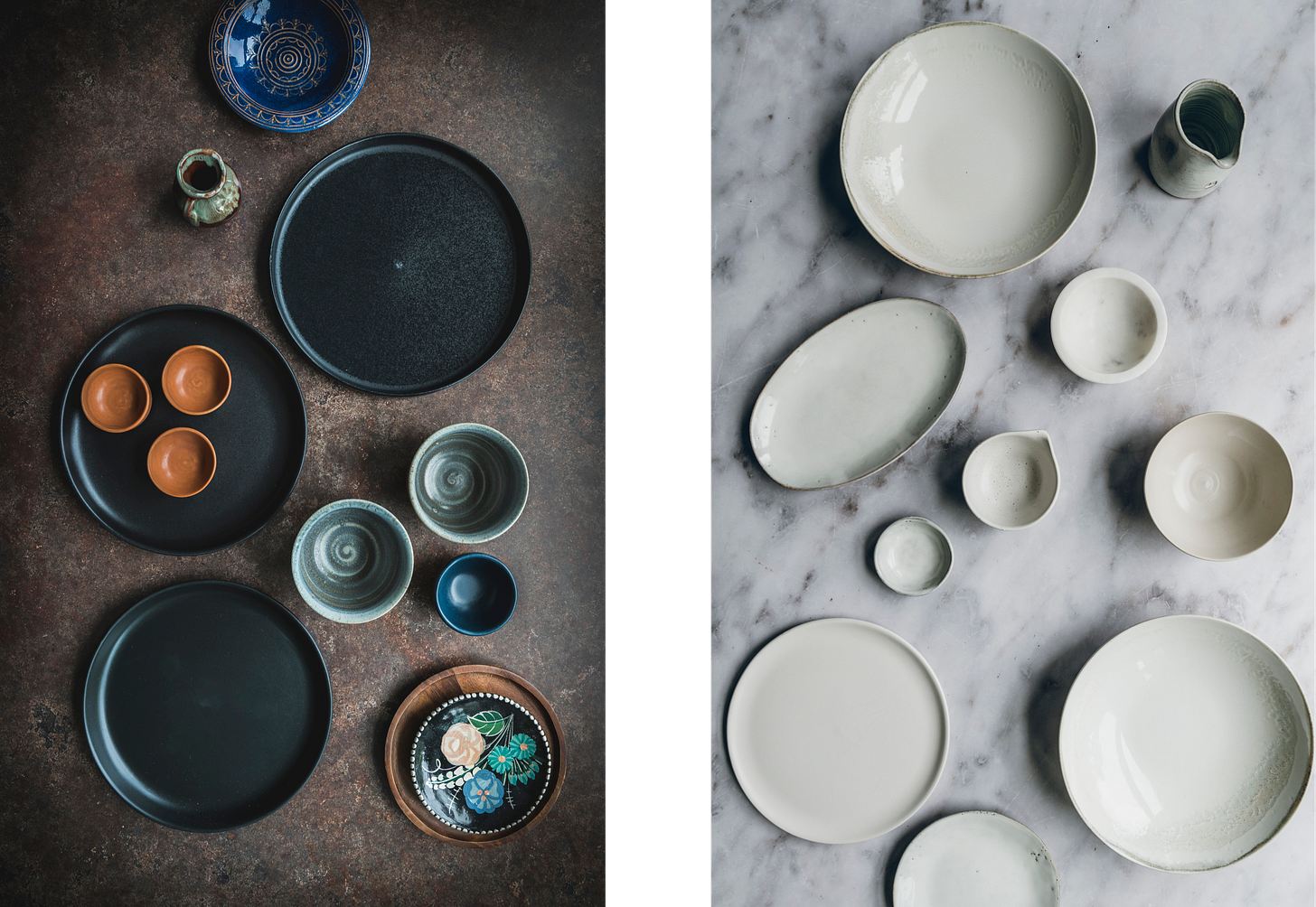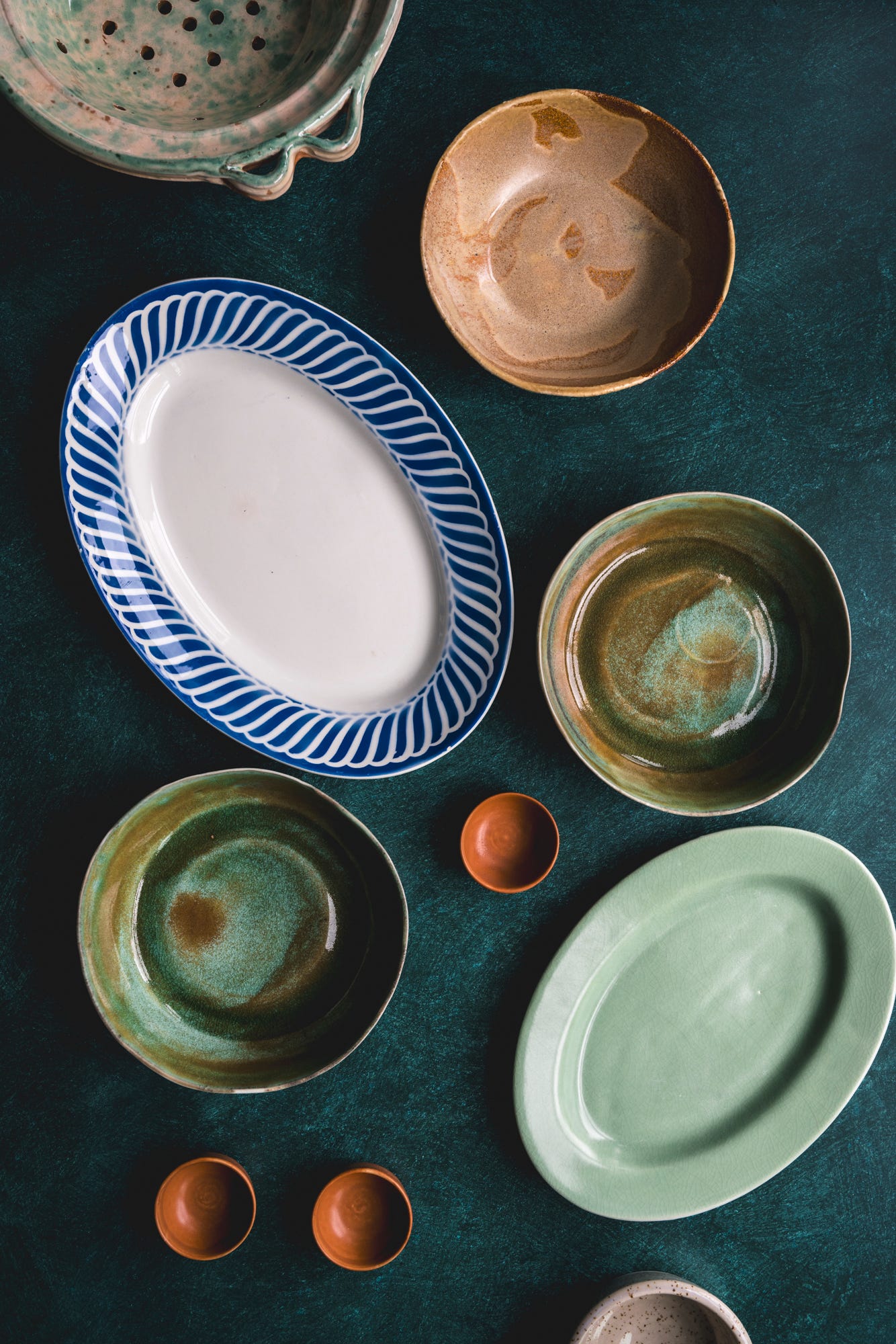My Favorite Photo Props and Where to Find Them: Ceramics
A list of some of my favourite props for food photography, how to use them and where to find them
Food photographers care about many things, but I haven’t yet found one that is not obsessed about collecting props.
We call “props” all those objects that will appear in the scene with the food we want to photograph, to help narrate a certain story. These will be plates, glasses, cutlery, napkins, backdrops, pinch bowls, kitchen gadgets…
The food must be the main subject, of course, but often what makes an image captivating are all the supporting actors helping the viewer imagine a larger scene.
Today I am starting this series with the most basic of props: ceramics.
Look for essentials
It’s easy to get too excited and before you realise, have a shelf full of plates and bowls. It’s happen before. If you like to cook food and would love to take pictures that are a bit more captivating, starting to build a nice ceramic collection will help, but it’s important to make guided decisions when purchasing.
This is why I think you should keep your eyes peeled for plates and bowls that you can use in multiple occasions. Think about the kind of aesthetic you like, or the kind of food you want to show. For example, if you are a cook that wants to show Japanese recipes, maybe start collecting some plates and bowls in that style. Or if you are a baker who advocates for heritage, better look for some rustic and organic ceramics.


Texture but not glossy
The camera loves texture. It adds dimension and interest to your photographs (let’s not forget that this is a 2D medium). Light picks up the texture and produces highlights and shadows, which is great to create contrast. But if the surface is not matte, it could end up being too shiny, which will put all the attention on the plate rather than the food in the plate.
You can shape the light with modifiers to avoid extra reflections, or even cancel them on Adobe Lightoom or Photoshop afterwards, but if you are not very proficient with those tools yet, the best bet is to buy a matte plate.

The right colors
To begin a ceramic collection, and following our own tip, it’s best to invest in neutral colors first that you’ll be able to use all the time. These can be creams, beiges and light browns if you go for an organic and airy look. Or blacks, dark browns and greys if you prefer photographing in a more moody style. You will be able to use the neutral set of plates in multiple occasions and for all sorts of dishes, and mix and match them when needed.
Something to keep in mid, though, is not too go too light or too dark. Stark white will blow out your exposure in the camera, meaning that because that one element will be so bright, everything else will appear too dark. The same happens if a plate is completely black. We don’t want to lose contrast, we want to have highlights and shadows, not just a blob of light or darkness in the middle of the photo.
So, start thinking what your camera needs instead. A beige plate will look pretty white on camera, while a dark grey one will appear to be black but still have some dimension to it.

If your style is modern and funky, go for the colors! I would still recommend to have some neutrals to balance things out, but be my guest and buy blues, greens, oranges, and pinks. It’s a lot of fun to play with the color wheel and style your food against a contrasting plate (ex. Orange food on a blue plate) or go monochromatic (ex. Yellow food on a yellow plate).

The most adequate dimensions
No matter the color palette you choose for your ceramic collection, you must know which sizes to avoid. Thinking about how the camera sees things rather than with our eyes, it’s always better to get smaller plates than normal. Salad plates will substitute dinner plates (only used for layering underneath a salad plate), and dessert plates, salad ones. Side plates (also called “bread plates”) work great for slices of cake or smaller portions of food.
Food will pop-up more if the plate is smaller and it will look more appetising if it fills up the container. Which is a good thing because it means spending less money and storage space!
Pinch bowls are also very helpful to fill up a corner or to showcase some ingredient without taking almost any space at all.

Look for interesting shapes
Look for plates with scalloped or irregular edges, small serving platters and interesting bowls. If you keep a neutral color palette, you can add interest displaying different shapes. Be careful, though not to take away from the food!

Where to find them
Depending on your style, you’ll be able to shop for ceramics in different places.
Rustic and vintage
If you like a rustic and vintage feel, the best options will be flea markets, thrift shops and antique stores. These are also great because we don’t need full sets to photograph, so you’ll be able to shop different pieces for very little. Some online shops in a rustic style are:
East Fork: US based shop. Farmhouse feel on their neutrals. Modern feel on the colored pieces.
Farmhouse Pottery: US based. Rustic and farmhouse feel.
Etsy: Global. You can find anything here, from vintage sets to artisan-crafted pieces.
Organic
If you want a more organic, Mediterranean feel, look for local artisans. The pieces will be pricier, but you’ll be helping out someone’s craft. There are shops where you can buy pieces from different ceramists, as they are more like curated collections. Local markets where you can meet the artisans in person are also great! Some online shops in this style are:
Bon Vent: I absolutely love this shop in Barcelona, and some of my ceramics are from here.
Nom Living: UK artisans.
Daylesford: UK curated shop.
Earthen: US curated shop. It feels organic but leans quite modern as well.
Modern
If you like a more modern, clean look, the shopping will be much easier! There are so many online shops where you can get ceramics from.
Luvhaus: US based. Artisan-made but with a modern feel. Lots of colors.
Notary Ceramics: US based. Artisan-made but with a modern feel. Great for neutrals. They have a Japanese collection.
H&M Home: Global. You can find many styles here, from “organic” to modern to romantic. It’s mass-produced and affordable.
Ikea: Global. Great for very affordable basics, but be careful with the reflections. Look for matte pieces.
Zara Home: Global. Normally it goes for an organic feel, but it’s mass-produced. You can find some minimalist as well as fun pieces.
Anthroliving-home: US based. On Anthropologie you can also find some fun pieces bistro-inspired as well as romantic and minimalist ones.
Other
Museums’ shops are also a great place to buy interesting pieces. But it needs some scouting as some things are quite kitsch. Stay away from the most obvious merchandise.
MoMA: The Museum of Modern Art in New York offers fun and modern pieces.
MET: The Metropolitan Museum of Art in New York has more heritage pieces.
Louvre: You can find some heritage inspired pieces.
The British Museum: English style plates and islamic art pieces.
To wrap it up
To wrap it up, here’s a summary of what we’ve been talking about:
Look for essentials that you can use over and over again and mix up.
Find tableware with texture, but avoid glossy reflections.
Start building your collection with neutral colors, and get some fun pieces for a pop.
Buy smaller plates you would normally eat in.
Look for interesting shapes to capture interest, but be careful not to take away from the food.
Search your pieces in flea markets, vintage shops, local artisans, online retailers and museums’ shops.
Have fun experimenting and tag me in your photos so I can see them!





What an educational article! I’m so excited for the rest of this series! Thank you, Elisabet
This was a great read and resource!